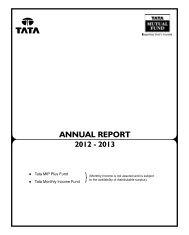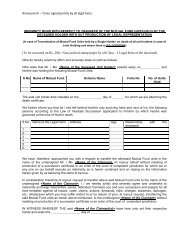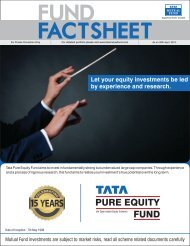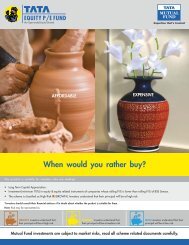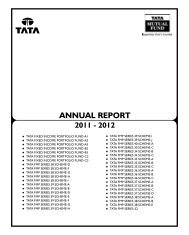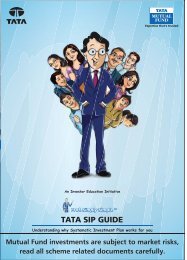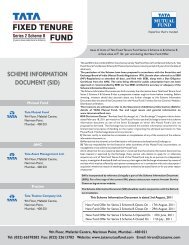Front Cover Page - Tata Mutual Fund
Front Cover Page - Tata Mutual Fund
Front Cover Page - Tata Mutual Fund
Create successful ePaper yourself
Turn your PDF publications into a flip-book with our unique Google optimized e-Paper software.
TATA FLOATER FUND<br />
E. THE INVESTMENT STRATEGIES<br />
The investment strategy of the scheme is to realize investment objectives.<br />
The Scheme would invest in companies based on various criteria including sound professional management, track record, industry scenerio, growth<br />
prospectus, liquidity of the securities, etc. The Scheme will emphasise on well managed, good quality companies with above average growth<br />
prospectus whose securities can be purchased at a good yield and whose debt securities are concerned investments (wherever possible) will be<br />
mainly in securities listed as investments grade by a recognized authority like The Credit Rating and Information Services of India Limited (CRISIL),<br />
ICRA Limited (formerly, Investment Information and Credit Rating Agency of India Limited), Credit Analysis and Research Limited (CARE) etc.<br />
In case of investments in debt instruments that are not rated, specific approval of the Board will be taken except in case of Government Securities<br />
being sovereign bonds. However, in case of investment in unrated securities prior board approval is not necessary if investment is within the<br />
parameters as stipulated by the board.<br />
The scheme would invest predominantly (i.e 65% of the net assets) in floating rate instruments and money market instruments. This scheme seeks<br />
to combine the advantage of floating rate papers and fixed rate papers.<br />
Interest rates are volatile with no clear direction of upward or downward movement in yield. Investment pattern will be flexible for the fund manager<br />
to shuffle between short term floating rate papers, money market instruments and long term floating rate papers, depending on the liquidity of the<br />
paper, spreads between different maturity segments and taking into consideration all other factors effecting bond market. The fund manager after<br />
analyzing the macroeconomic situations may take exposure to fixed rate paper upto 35% of the corpus to take advantage of interest rate volatility.<br />
Any change in the asset allocation affecting the investment profile of the scheme shall be effected only in accordance with the provisions of<br />
regulations 18-15A of SEBI (<strong>Mutual</strong> <strong>Fund</strong>) Regulations 1996.<br />
Risk Mitigation measures for debt and related Investments:<br />
Type of Risk<br />
Liquidity Risk<br />
Credit Risk<br />
Interest Rate<br />
Risk<br />
Regulatory Risk<br />
Measures to mitigate risk<br />
Focus on good quality paper at the time of portfolio construction<br />
Portfolio exposure spread over various maturity buckets to inline with maturity of a scheme<br />
In house dedicated team for credit appraisal<br />
Issuer wise exposure limit<br />
Rating grade wise exposure limit<br />
Independent rating of scheme portfolio by recognized rating agency.<br />
Periodical portfolio review by the Board of AMC<br />
Close watch on the market events<br />
Active duration management<br />
Cap on Average Portfolio maturity depending upon the scheme objective and strategy<br />
Portfolio exposure spread over various maturities<br />
Online monitoring of various exposure limits by the <strong>Front</strong> Office System also as a backup, manual control are<br />
implemented.<br />
Trading in Derivatives<br />
Subject to SEBI (<strong>Mutual</strong> <strong>Fund</strong>) Regulations, 1996, the Scheme may use techniques and instruments such as trading in derivative instruments to<br />
hedge the risk of fluctuations in the value of the investment portfolio. The Scheme shall enter into derivative transactions for the purpose of hedging<br />
and portfolio balancing in accordance with the guidelines issued by the SEBI.<br />
A derivative is an instrument whose value is derived from the value of one or more of the underlying assets which can be commodities, precious<br />
metals, bonds, currency, etc. Common examples of Derivative instruments are Interest Rate Swaps, Forward Rate Agreements, Futures, Options,<br />
etc.<br />
The scheme may use derivative instruments like Interest Rate Swaps, Forward Rate Agreements/ Interest Rate Futures, Interest Rate Options or<br />
such other derivative instruments as may be introduced from time to time and as may be permitted under the SEBI (<strong>Mutual</strong> <strong>Fund</strong>) Regulations.<br />
Additional derivative exposure in line with SEBI vide its Circular No. Cir / IMD / DF / 11 / 2010 dated August 18, 2010:<br />
1. The cumulative gross exposure through debt and derivative positions shall not exceed 100% of the net assets of the scheme.<br />
2. The <strong>Mutual</strong> <strong>Fund</strong> shall not write options or purchase instruments with embedded written options.<br />
3. The total exposure related to option premium paid shall not exceed 20% of the net assets of the scheme.<br />
4. Cash or cash equivalents with residual maturity of less than 91 days will be treated as not creating any exposure.<br />
5. Exposure due to hedging positions shall not be included in the above mentioned limits subject to the following<br />
a. Hedging positions are the derivative positions that reduce possible losses on an existing position in securities and till the<br />
existing position remains.<br />
b. Hedging positions cannot be taken for existing derivative positions.<br />
19




